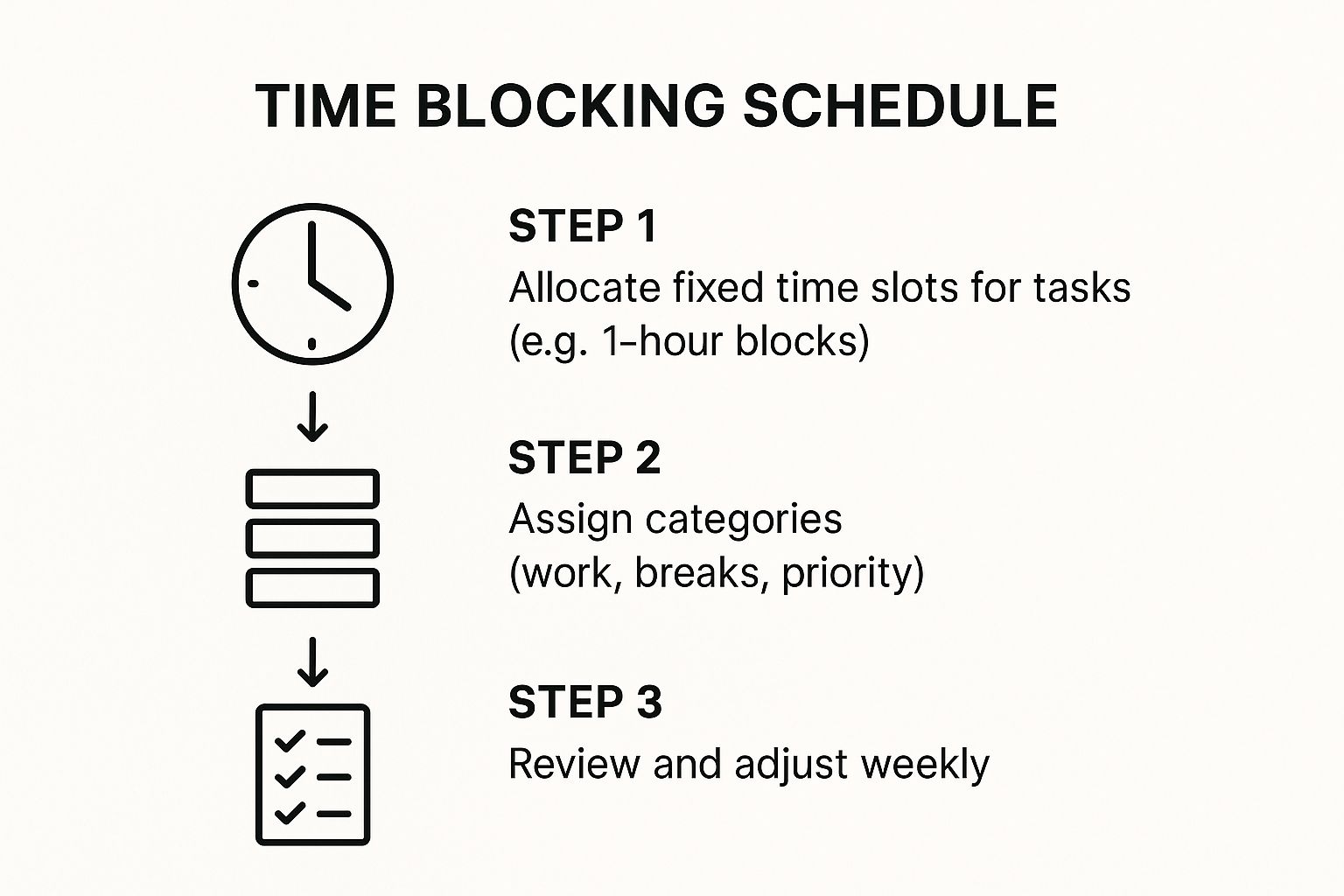Your Time Blocking Schedule That Actually Works
Tired of endless to-do lists? Build a time blocking schedule to reclaim your focus and drive productivity. A practical guide for founders and busy pros.
What is a time-blocking schedule? It's a productivity method where you plan your day in advance, assigning every single task to a specific "block" of time on your calendar. This isn't just about making a list; it’s about shifting from a reactive, chaotic workflow to a proactive schedule that commands your focus and respects your time. For busy founders, this isn't a "nice-to-have"—it's a survival mechanism.
Moving Beyond the Endless To-Do List

If you're a founder, you know the to-do list is a monster that never sleeps. No matter how many tasks you slay, it grows back stronger, often with more urgent demands than before. You're left in a constant state of reaction, feeling swamped but not necessarily productive, just lurching from one fire to the next without making real strategic headway.
Traditional task lists fail under the intense pressure of a founder's world because they're missing two crucial things: context and commitment. They tell you what to do, but they're silent on when or for how long. A time-blocking schedule completely flips this dynamic on its head.
The Shift From Reactive to Intentional
Instead of staring at a list and wondering where to start, you simply look at your calendar. It’s a subtle change, but the psychological impact is huge. You go from a state of questioning ("What should I tackle next?") to one of pure execution ("It's time for this."). By giving every minute a job, you're forced to make deliberate, high-stakes decisions about your most precious resource—your time.
This method also forces a confrontation with reality. You quickly learn how long things actually take, exposing the critical gap between just being busy and being genuinely productive.
The core idea isn't to prioritize what’s on your schedule, but to schedule your priorities. This means your most important work—the tasks that truly move the needle for your business—get a permanent, non-negotiable home on your calendar.
Scheduling Your Priorities
This proactive approach is all about "paying yourself first" with your time. You intentionally carve out blocks for your most critical work—the deep thinking, the product development, the strategic planning—before the day gets hijacked by meetings, emails, and other people's agendas.
Once you make this shift, the benefits are almost immediate:
- It kills decision fatigue. With your day planned out, you waste zero mental energy figuring out what to do next. You just do it.
- It protects deep work. It ring-fences the large, uninterrupted blocks of time you desperately need for complex problem-solving and creative breakthroughs.
- It gives you clarity. A visual calendar provides a stark, realistic picture of your actual capacity for the day and week.
- It connects daily actions to big goals. It ensures the small things you do every day are actually chipping away at your larger strategic objectives. To see how this fits into a bigger picture, check out our guide on creating a quarterly planning template.
To truly escape the tyranny of the endless to-do list, it helps to be a student of mastering time management. Adopting a time-blocking schedule is the single most powerful first step you can take. It’s how you finally start running your day, instead of letting your day run you.
Building Your First Time Blocking Template
Creating your first time-blocking schedule is like drafting the architectural blueprint for your most productive self. It starts with something that feels almost too simple: a brain dump.
Seriously. Get every single task, commitment, and nagging "should-do" out of your head and onto a list. Don't filter, don't organize—just get it all out. This clears the mental fog and gives you a raw inventory of what's demanding your attention.
Once it's all on paper (or a screen), the real work begins: ruthless prioritization. It’s so easy to get sucked into the vortex of tasks that are screaming the loudest, but real progress comes from tackling what's actually important. You have to learn to distinguish the truly significant from the merely urgent. This means tying your daily actions back to your bigger, long-term goals. If you're struggling to define those, our guide on how to set goals effectively provides a rock-solid framework.
From List to Visual Plan
Now you get to translate that prioritized list into a visual plan, usually on a digital calendar. This is where you stop reacting to your day and start commanding it.
First, block out your non-negotiables. Sleep. Meals. A workout. Family time. A burned-out founder is a useless founder, so treat your personal recovery time with the same reverence you'd give a board meeting. It's not optional; it's essential for long-term survival.
With your personal blocks locked in, you can start slotting in your work. Here's where most people stumble: they are wildly optimistic about how long things take. Be brutally honest with yourself. If a task feels like it will take an hour, block out 75 or even 90 minutes. This accounts for the inevitable snags, interruptions, and the mental gear-shifting between tasks.
The point isn't to cram every second of your day with frantic activity. It's about allocating your time with intention. A truly effective schedule has buffers and white space built right in, because rigidity is the enemy of actual progress.
This whole process is a loop, not a one-and-done setup.

As the graphic shows, you're meant to refine this system every week based on what actually happened, not what you hoped would happen.
For a concrete look at how this plays out, here's a sample schedule for a founder balancing deep work, meetings, and personal sanity.
Sample Time Blocked Day for a Founder
| Time Block | Task Category | Specific Task Example | Goal |
|---|---|---|---|
| 7:00 AM - 8:00 AM | Personal Time | Workout & Morning Coffee (no phone) | Energize body and mind for the day |
| 8:00 AM - 9:00 AM | Planning & Admin | Review weekly goals, clear urgent emails | Set daily priorities, clear distractions |
| 9:00 AM - 12:00 PM | Deep Work | Code new user onboarding flow | Make significant progress on Q3 KR#1 |
| 12:00 PM - 1:00 PM | Lunch & Break | Eat away from desk, take a short walk | Recharge and reset focus |
| 1:00 PM - 2:30 PM | Meetings | Sync with freelance designer, investor call | Align team, secure resources |
| 2:30 PM - 3:00 PM | Buffer | Stretch, grab water, handle unexpected Slack pings | Transition without stress |
| 3:00 PM - 5:00 PM | Shallow Work | Respond to non-urgent emails, update CRM | Maintain momentum, clear the decks |
| 5:00 PM - 5:30 PM | Wrap-up | Plan tomorrow's top 3 tasks, log daily wins | End day with clarity, build satisfaction |
| 5:30 PM Onwards | Personal Time | Family dinner, read, relax | Disconnect completely to prevent burnout |
This isn't a rigid mandate, but a flexible blueprint. The key takeaway is how different types of work are grouped to protect focus and manage energy, not just time.
Designing a Sustainable Weekly Template
A truly sustainable schedule is a balanced one. Getting that balance right is both an art and a science, but here’s a solid structure to start with:
- Deep Work Blocks: These are your sacred, two-to-four-hour chunks for the hardest cognitive lifts. Protect them fiercely and schedule them during your peak energy windows.
- Shallow Work Blocks: Batch the little stuff—like answering emails or clearing out Slack messages—into shorter, 30-60 minute blocks. This stops them from splintering your day into a million unfocused pieces.
- Meeting Blocks: Group your meetings together. A "meeting afternoon" is far less disruptive than calls scattered randomly throughout your day, which constantly break your flow state.
- Buffer Time: Sprinkle 15-minute buffers between your main blocks. This gives you time to transition, grab a coffee, or just breathe. It’s the secret sauce that makes the whole schedule work.
This kind of structured approach has massive real-world implications. In the UK, daily procrastination once cost employees over two hours a day. While that number has fallen to 43 minutes, it still costs British businesses an estimated £76 billion annually. This shows the staggering economic upside of disciplined scheduling.
If you're using a system like SprintDojo, you can tag your tasks by category before they even touch your calendar, making this whole process incredibly smooth. And if you need a little inspiration, check out some existing time box templates to see how others structure their high-performance days.
Putting Your Time Blocking Schedule Into Action
So you've designed a beautiful schedule. It's color-coded, logical, and a work of art. But a perfect schedule is just a pretty document until you start living it.
The real test begins when the day throws its first punch—an "urgent" Slack message, a last-minute meeting request, or a "quick question" that spirals into a half-hour distraction.

This is where theory smacks into reality. Sticking to your plan isn't about rigid inflexibility; it’s about having a system that can absorb these shocks without shattering your entire day. As a founder, your ability to manage these interruptions is a make-or-break skill.
Your Secret Weapon: The Buffer Block
One of the most powerful strategies for navigating the daily chaos is the buffer block. This isn’t just empty space on your calendar; it's intentionally scheduled downtime between your main activities. Think of it as the suspension on a car—it’s designed to smooth out the bumps in the road.
A 15-minute buffer after a deep work session gives you time to decompress before jumping into a client call. It's a built-in slot for grabbing water, stretching, or dealing with that one "urgent" email that just popped up.
Without buffers, your schedule becomes brittle. One minor delay creates a domino effect of stress and frantic rescheduling.
A schedule without flexibility is a schedule destined to fail. The goal is not to become a robot, but to create a resilient framework that guides your focus while accommodating the unpredictable nature of work.
Building in these small pockets of time gives you the freedom to handle minor issues on the spot, preventing them from derailing the high-priority blocks you fought so hard to protect.
Conquering Your Own Resistance
Sometimes, the biggest obstacle isn't an external interruption. It's you. You look at a two-hour block for "Q3 Financial Modeling" and feel a sudden, overwhelming urge to clean out your inbox instead.
This is completely normal. Our brains are wired to seek the path of least resistance and the instant gratification of completing small, easy tasks. To combat this, you need to build discipline and honor the commitments you've made to yourself.
Here are a few practical tips to stay on track:
- Start Tiny: If a two-hour block feels intimidating, start with just 25 minutes. The act of starting is often the hardest part. Once you're in it, momentum takes over.
- Kill Temptations: Close unnecessary browser tabs. Put your phone in another room. Turn off notifications. Create an environment where the intended task is the path of least resistance.
- Bring in an Accountability Partner: A tool like SprintDojo acts as your digital accountability partner. By integrating your task list with your calendar, it creates a seamless flow from planning to doing. Prompts for upcoming blocks help you transition, building the habit of sticking to your plan.
The Non-Negotiable Shutdown Ritual
How you end your day is just as important as how you start it. A shutdown ritual is a consistent, non-negotiable routine you perform at the end of your workday to signal to your brain that it's time to disengage. It's the final, decisive block on your calendar.
This could be a simple 15-minute process:
- Review what you actually got done today.
- Triage any leftover items in your inbox—decide what needs a response now, what can wait, and what can be deleted.
- Outline your top 1-3 priorities for tomorrow.
- Close all work-related tabs and applications. Shut down your computer.
This ritual prevents work from bleeding into your personal time, a common path to burnout for driven founders. It provides a sense of closure and ensures you start the next day with a clear plan, not a lingering sense of unfinished business.
For those working remotely, maintaining this boundary is critical. Specific strategies can significantly boost your efforts, as explored in these 5 Tips on How to Focus and Be More Productive When Working From Home.
Advanced Time Blocking for Peak Performance
Once you've nailed the basics of scheduling, you can start turning your time block from a simple plan into a real competitive advantage. This is where you graduate from just managing your time to strategically engineering it. The goal isn't just to organize your work, but to amplify your focus and energy.
One of the most powerful moves you can make is task batching. It’s a simple concept: group similar, low-focus tasks into a single, dedicated time block. Instead of letting emails, Slack pings, and other small administrative tasks chop up your day, you quarantine them.
For example, a founder could schedule a daily 45-minute "Comms Power Hour" to blast through all non-urgent emails and messages at once. This single practice radically cuts down on context switching—the mental tax you pay every time your brain has to jump between different kinds of work. By batching, you shield your best mental energy for the deep work that actually moves the needle.
Designing Your Week with Theme Days
To take this a level deeper, you can introduce theme days. This means dedicating entire days to a single high-level business function. It's an incredibly effective way to create sustained focus on the different pillars of your company, ensuring critical areas don't get pushed aside by whatever feels urgent that day.
A founder’s themed week might look something like this:
- Monday: Product Development & Strategy
- Tuesday: Marketing & Growth Experiments
- Wednesday: Team Meetings, 1-on-1s & Internal Syncs
- Thursday: Sales & Fundraising
- Friday: Admin, Financial Review & Weekly Planning
This structure forces you to go deep on one topic for a whole day, unlocking a level of creative and strategic thinking you'd never reach by jumping between these functions daily. It takes serious self-discipline to stick to, but the payoff in clarity and real progress is massive. If you need to build that muscle, you can learn more about how to improve self-discipline and make these advanced strategies feel like second nature.
Aligning Your Schedule with Your Energy
The most sophisticated time blockers account for a resource even more finite than time: your energy. We all have natural energy cycles—ultradian rhythms—with peaks of high focus and predictable lulls. The masterstroke is scheduling your most demanding, creative work during your personal peak hours.
Are you sharpest first thing in the morning? That’s your golden window for writing that investor update or tackling a thorny piece of code. Get a second wind after lunch? Use that period for brainstorming sessions or complex problem-solving.
Your time blocking schedule evolves from a simple daily plan into a strategic weapon when it reflects not just what you have to do, but when you are biologically best equipped to do it.
This science-backed approach ensures your best brainpower is aimed squarely at your biggest challenges. It’s a fundamental shift from just filling your day to truly optimizing it. In a world where every minute is currency, this intentionality is critical. The reality is, for many, time lost to commuting just evaporates. With the average U.S. daily commute stealing 15 to 29 minutes each way, people lose roughly 13 full days a year just traveling. This lost time has fueled the rise of time blocking calendars, as people fight to reclaim their focus. You can discover more insights about these market trends on dataintelo.com.
By weaving together task batching, theme days, and energy alignment, your calendar stops being a list of appointments. It becomes a dynamic system that drives long-term goals—turning your schedule into the ultimate tool for strategic execution.
Choosing Your Time Blocking Tools

Let's be honest: the right tech can make your time-blocking schedule feel like a superpower. The wrong tools, however, just add friction, turning a system meant for clarity into a source of constant frustration. Your goal is to find a setup that feels like an extension of your brain, not another clunky app you have to manage.
For most people, a standard digital calendar like Google Calendar or Outlook is the perfect place to start. They’re free, familiar, and get the basic job done. You can easily color-code your day into blocks for deep work, meetings, and personal time. Simple. Effective.
But as you get more serious about this, you’ll start to see the cracks. Standard calendars are great for scheduling things, but they're terrible at managing the tasks that need to happen within those scheduled blocks. This is where dedicated tools completely change the game.
Standard Calendars vs Specialized Apps
Specialized time blocking apps are built from the ground up for this exact methodology. Many of them offer slick drag-and-drop task integration, smart scheduling suggestions, and even detailed analytics on where your time actually went. The trade-off? Usually a learning curve and another monthly subscription.
Here’s how to think about it for a busy founder:
| Tool Type | Pros | Cons |
|---|---|---|
| Standard Calendar | - No extra cost<br>- Familiar interface<br>- Universal integrations | - Lacks task management features<br>- Requires manual data entry<br>- No built-in analytics |
| Specialized App | - Seamless task-to-calendar flow<br>- Advanced analytics and insights<br>- Built for focus | - Often requires a paid subscription<br>- Can be overly complex<br>- Another app to manage |
There's a reason the market for these tools is exploding. It was valued at around USD 1.5 billion in 2023 and is on track to hit USD 4.8 billion by 2032. This isn't just a niche trend; it's a fundamental shift in how people are demanding control over their time. You can learn more about time blocking app market growth to see the data behind this movement.
The ultimate goal is to create a single source of truth. Juggling tasks in one app and your schedule in another creates a constant, low-grade mental tax that undermines the very focus you're trying to achieve.
This is exactly where integrating a project management tool directly with your calendar becomes a game-changer. A system like SprintDojo is designed to bridge this exact gap.
Instead of manually copying tasks from your to-do list into empty calendar slots, you connect your entire task list directly to your schedule. This creates a fluid, unified system where your work and your time finally live in the same place. It streamlines your entire planning process, from high-level goals all the way down to the minute.
Sticking Points & Common Questions
Even with a perfect template, jumping into time blocking can feel... weird. It’s a huge shift from how most of us are used to managing our days, so hitting a few snags is completely normal. Let's walk through the most common questions that pop up when you're first getting your sea legs.
The big one, always, is: "What happens when an emergency or unexpected task blows up my schedule?" Welcome to being a founder. Life happens. That’s why your schedule has to be a guide, not a rigid cage.
This is exactly why you build in buffer blocks—those small, 15-30 minute gaps between your major tasks. Think of them as your secret weapon. They give you the flex time to handle an urgent call or a sudden fire without torpedoing your entire day. If a task is truly massive and urgent, it's okay to reshuffle. The goal here is intentionality, not perfect, unbroken execution.
How Much Detail Is Too Much?
Another common hurdle is figuring out the right level of detail. Do you really need to schedule every single five-minute email?
Short answer: definitely not. Over-scheduling is a fast track to decision fatigue and feeling like you're constantly behind. You'll spend more time managing the schedule than doing the work.
A good rule of thumb is to block time for categories of work, not every tiny to-do.
- Good: "9:00 AM - 9:45 AM: Clear Inbox & Slack"
- Too Detailed: "9:00 AM: Reply to Sarah's email. 9:05 AM: Check #marketing channel. 9:10 AM: Archive old messages."
The first approach gives you clear direction without creating needless pressure. It respects your ability as a professional to manage the micro-tasks within that dedicated block.
The most effective time blocking schedule feels like a supportive framework, not a micromanaging boss. It guides your focus toward your priorities while leaving room for professional judgment and real-world flexibility.
What If I Underestimate How Long Something Takes?
Finally, people always ask, "What if a task takes way longer than I planned?" First of all, welcome to the club. This happens to everyone, all the time. This isn't a failure; it’s a valuable learning opportunity.
When a task spills over its allotted time, you really have two choices:
- Borrow from a buffer: Use that planned buffer time to wrap it up. This is exactly what it’s for.
- Schedule a follow-up block: If it’s a big task, stop when the block ends. Then, find another spot later in the day or week to schedule a "Part 2" and finish it.
This process is precisely how your time blocking schedule gets smarter. Each time you underestimate, you're gathering real-world data. After just a few weeks, your ability to forecast how long tasks actually take will improve dramatically. You'll move from aspirational planning to a realistic, battle-tested schedule that genuinely works for you.
Sprint Smarter. Forecast Every Week.
Log wins. Build momentum. Let AI show you if you're on track to hit your sprint goal—before it's too late.
Join the waitlist and be the first to unlock predictive clarity for your team.